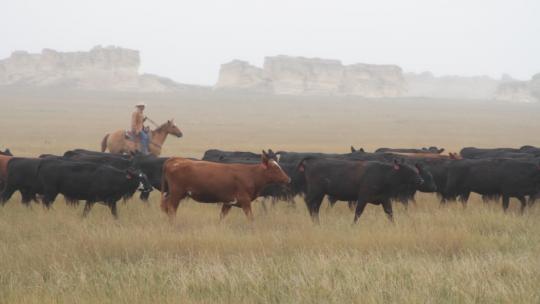
SCOTT CITY — For more than 40 years the Stacy Hoeme family in Scott City has been on the cutting edge of conservation practices that help their farm’s profitability, soil health, water quality and wildlife habitat.
Their dedication to conservation was recognized by Sand County Foundation as the recipients of the 2018 Kansas Leopold Conservation Award.
Stacy Hoeme and his son, Chaston, farm about 9,000 acres along the Smoky Hill River, and another 10,000 acres in Scott County.
Thanks to a grazing program developed on their western Kansas farm and ranch, the Hoeme family’s land boasts an array of plants that supports some of the largest known populations and densities of lesser prairie chickens.

The Hoeme’s ranch hosted the largest study ever conducted on the rare bird.
They also participated in a large research project that sought to learn why mule deer were in decline.
When biologists wanted to re-establish swift foxes on tribal lands in South Dakota, they captured, transported and released 12 swift foxes from the Hoeme’s land.
The insights gained on their land have influenced how government, conservation partners, and other landowners manage the landscape for wildlife.
 ABOUT THE SAND COUNTY FOUNDATION
ABOUT THE SAND COUNTY FOUNDATION
In 1967, Sand County Foundation in Madison, Wisconsin, created a successful partnership among a group of private landowners to protect the land surrounding the famous “Shack” property of Aldo Leopold, America’s foremost conservation thinker. This pioneering cooperative venture led landowners to commit to voluntary conservation while raising awareness of Leopold’s land ethic, which inspires thousands of other owners of working land.
When Leopold wrote his visionary A Sand County Almanac, published in 1949, he introduced conservation ideas that penetrated the public’s conscience just as much then as they do today. Leopold advanced individual responsibility for private land management, and recognized that a landowner’s profitability and economic growth are tied to conservation success. Since its publication, A Sand County Almanac has been described as the most influential conservation book. It remains a best selling environmental book, demonstrating how relevant these ideas are today.
We’ve come a long way since mobilizing our first landowner partners to conserve Leopold’s sandy farmland in Wisconsin. Today, our impact spans the U.S., and is a direct reflection of what our donors and partners can achieve when landowners are encouraged to lead the way to improving our nation’s natural resources.
– SUBMITTED –
